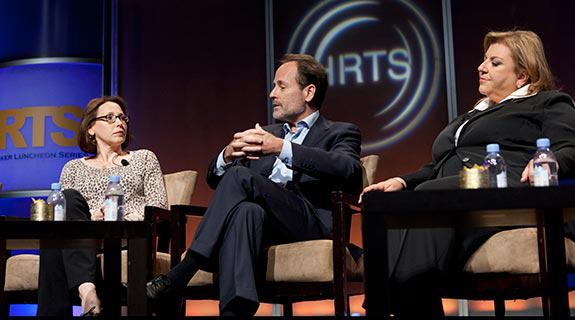FX Networks CEO John Landgraf thinks “it’s going to be a bumpy half-decade to decade” as the television industry figures out the best ways to measure and monetize content as viewer habits change and new platforms and providers rise in popularity.
Landgraf made his comments alongside several other television executives gathered at the Beverly Hilton on Wednesday for a discussion on the state of the industry.
The FX boss, along with Lionsgate Television Chairman Kevin Beggs, Yahoo CMO Kathy Savitt, ICM Founding Partner Chris Silbermann and Jackal Group Chairman Gail Berman were split on whether linear television would still be the driving force in the industry in years to come and whether newcomers like Netflix, for example, should be forced to show their ratings numbers.
Berman blamed the entertainment media for allowing Netflix to maintain its practice of keeping its viewership numbers to themselves, adding “It’d be nice for everyone to be playing with the same set of rules.”
Lionsgate’s Beggs said he wasn’t “knocking on the door too loudly” for numbers at Netflix for his hit show Orange is the New Black because “they seem very happy. So I’m happy about that.”
And while Yahoo’s Savitt talked up the arrival of fan darling Community on Yahoo! Screen and the Internet company’s ability to serve as the “connective tissue” between audiences and content, she was mum when asked whether they would be following Netflix’s lead and withhold viewer data.
“‘I don’t know’ is the answer,” Savitt said. “We have not made any decisions as to how and with what frequency we might release [data].”
Berman praised Yahoo for giving a show like Community a second life, but said the Internet company was benefitting from the money and efforts already expended by NBC.
“The question going forward is going to be ‘what kind of content will Yahoo be able to afford and what kind of creators can we find who can develop appropriately for Yahoo,” Berman told the Beverly Hilton audience.
Landgraf approached the perennial question about the accuracy and adequacy of ratings data by turning the question slightly on its head.
“For the purposes of our industry, the only truly valid measurement of success is how many quality original series is the ecosystem sustaining,” Landgraf said.
Part of that bumpy road ahead of the industry is figuring out some optimal range of outlets, where three channels is too few, but 1,000 is too many.
Silbermann questioned whether there was enough good talent to go around for all of the new distributors and platforms coming on board.
And he said the cost of sustaining such a rapidly expanding ecosystem is worrisome.
“The amount of money that has to be spent on marketing to break through the clutter is a big issue,” Silbermann added. “It is similar to what the film business has had to do.”
Savitt touched on a major worry for the linear networks–maintaining branding as shows move to streaming services—and pointed to a Yahoo survey where only 20 percent of respondents were able to correctly identify where they watched a series that they loved.
“We think we have to be the enablers for the networks to retain those branding rights,” Savitt said. “You did pay for the show. It’s very important for us to know where the content came from.”
Landgraf said it was “vital to the future economic health of the industry” to work out the branding equation with the SVOD community.
“[Brands] don’t have to be linear channels,” Landgraf said. “But if brands can’t hold together and be a mediating principle in discovery, we’re going to be in a lot of trouble.”
Landgraf, Savitt, and the other executives were speaking at the Hollywood Radio and Television Society’s State of the Industry Newsmaker Luncheon.
Tags:













































__twocolumncontent.jpg)











